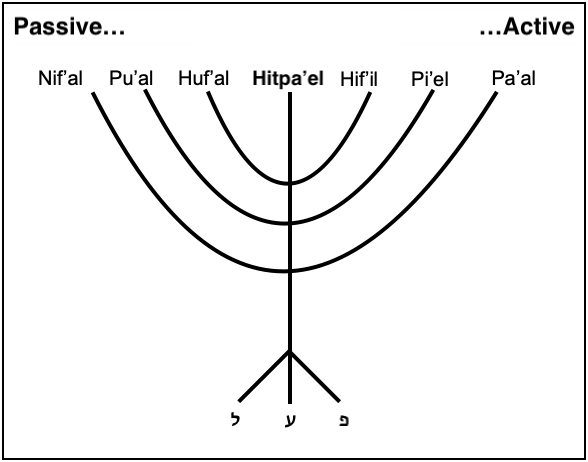Israel Diaries #5
Yes, you see it, too: it’s a menorah! This hit me before I saw it referred to as such elsewhere. You can imagine where my head went with this: Hanukkah > Festival of Lights > Diwali > Hinduism > Saraswati > Knowledge of the self > reflexive/reciprocal > Hitpa’el!

My first Hebrew crisis
I had taught myself the Alefbet more than a year ago and know it well (less so in cursive) and I only formally started learning Hebrew at my local Jewish Centre in October last year.[1] It's not going as fast as I would like, yet I find it highly stimulating and enjoyable. Last evening I hit my first crisis, when frustration drove me close to tears.
We had arrived at verbs and their various ‘types.’ I parenthesise types, for I had no idea how the various ‘types’ were related, why there were seven, or what the other six were. We were dealing with only one ‘type’ and drilling down into its conjugations. In the meantime, I still had no reference to any structure, and could not visualise where anything fitted in. It has been incredibly frustrating having each new piece of information hanging in mid-air for no rhyme or reason, making something as fundamental as verbs essentially arbitrary. This made no sense to me…
…until late last night, when I came across a short YouTube video titled Understanding Hebrew Verbs - The Binyanim explained visually! on the Hebrew4Learners channel. It seemed, at first, to have been designed for children, but this proved deceptive. What a revelation![2] I am familiar with the concept of radicals, both from Chinese and from Arabic (neither of which I speak), which took me immediately to the root of my problem —sorry! For the most part, Hebrew uses the same triconsonantal root system as Arabic. The elegance of the Arabic k-t-b (write) being the root of kataba (he wrote), kitab (book), katib (writer), maktaba (library), maktub (written), etc., I was now looking forward to discovering in Hebrew.
Mind-blowing in its elegance is how the seven stems (that’s what they are) form this wonderful, philosophical correspondence and balance between active verbs and passive verbs. Its conceptual completeness lies in the arrangement of verbs along a gradation of distance between subject and object, starting from infinitely far to closer in, stem-by-stem, until subject and object are unified as one. No object - indeterminate object - determinate object - coincident object, or, put another way, the proximity of the subject to the effect of the action on the object. This is pure beauty that sent my heart racing. I imagined the structure below, which simply blew my mind:

Yes, you see it, too: it’s a menorah! This hit me before I saw it referred to as such elsewhere. You can imagine where my head went with this: Hanukkah > Festival of Lights > Diwali > Hinduism > Saraswati > Knowledge of the self > reflexive/reciprocal > Hitpa’el!
Wow!
Look carefully at the arrangement of this menorah: active verbs on the right; passive verbs on the left; reflexive/reciprocal verbs in the middle.[3] Working inwards from both sides, we find:

So far, so good, I hope. Thereafter, I went on to the sequel: Decoding the Binyanim, the patterns of Hebrew verb stems. Each stem derives its verbs from its own distinctive inflection of the root, making its verbs identifiable by a unique and consistent pattern of consonantal affixes.

These stem-unique patterns continue through to consistent tense formations by stem. The verbs then conjugate according to person, gender and number. And so the Pa’al conjugations hanging in the air finally found their station, alongside all the conjugations of the other six stems. I would like to think that I now have some idea of what I’m trying to learn. All that remains, I hope, is to find the most effective strategy for actually learning all this stuff. My hunch is to focus on the same root radicals in corresponding pairs of stems, working from the outside in: Pa’al - Nif’al; Pi’el - Pu’al; Hif’il - Huf’al; and finally, Hitpa’el. No doubt, the next crisis lies in wait to drive me crazy all over again.
Finally, my dear reader, if you see any howling flaws in my understanding, please, please be kind enough to point them out to me. I would greatly appreciate it.
Notes:
- I had better mention that I do not speak the language of instruction and from time to time, the teacher is kind enough to translate her explanations for me, which I greatly appreciate. Yet, I must confess that it's sometimes hard going, since I only get the barest of bare bones.
- Please do not take this as a Hebrew lesson. I am barely in a position to teach myself. What follows is my understanding at this point. No doubt, it will change as I learn more.
- The equivalent diagram in Understanding Hebrew Verbs - The Binyanim explained visually! and in Decoding the Binyanim, the patterns of Hebrew verb stems can be improved by not including Hitpa’el in active verbs, since those verbs are both active and passive, i.e., subject and object coincide, hence reciprocal/reflexive, and so forms a special, culminating stem (the middle candle of the menorah). Philosophically, Hitpa’el occupies the same conceptual position as Saraswati in Hinduism, goddess of knowledge of the self. [Edit 14.1.23 - I've just had the thought that I should take another look at the Dialogue between Krishna and Arjuna. There might be more to it than I have hitherto realised] There is a more "grown-up" explanation of the Binyanim here, which I found challenging.
